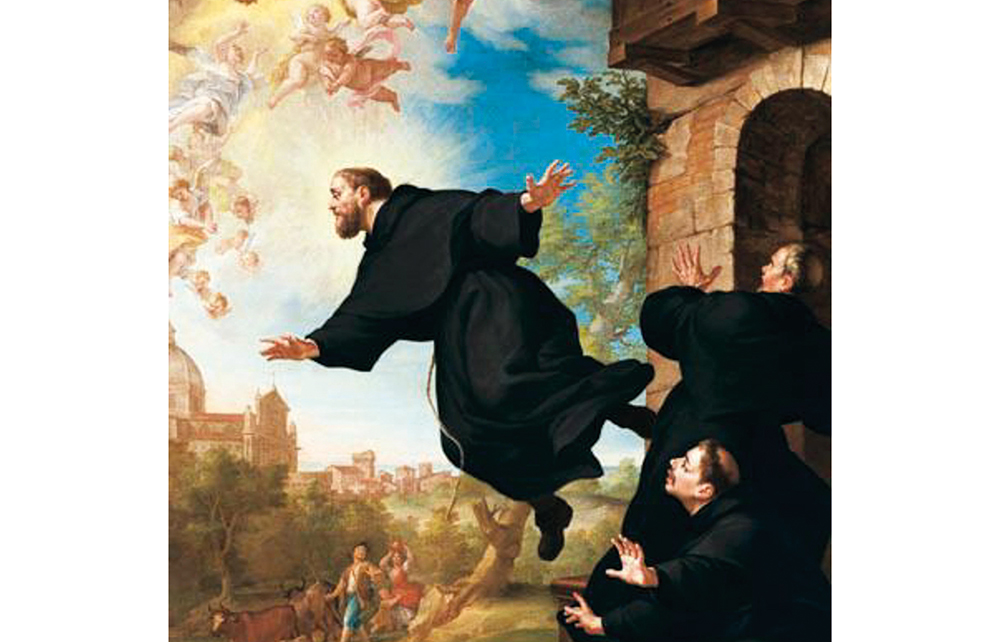The ‘ordinary academic mind’, William James wrote, struggles to recognise things which ‘present themselves as wild facts with no stall or pigeonhole’. The Yale professor Carlos Eire has a passion for them. His erudite, wilfully eccentric study of baroque Catholicism glories in the supernatural powers of holy persons. He showcases two kinds of miracles they performed: levitation and bilocation, the ability to be in two places at once. Through him, we meet St Joseph of Cupertino, who liked to nest in the tops of trees, and Sister María de Ágreda, a Spanish nun who made 500 trips to missionise the New World without once leaving her convent. Although their feats were facts – widely attested and discussed at the time – we now know them to be impossible. Eire invites us to be sceptical about our doubts and to ask what it would mean to accept them as real.
It had been amazing enough when St Thomas Aquinas rose three feet into the air…
Miracles like these were no vestiges of primeval times. They gained ground with literacy, print and religious reform. Levitation is mentioned in the New Testament – Simon Magus, the rival of Christ’s apostles, flew – but was not a mark of sainthood until the later Middle Ages, when hagiographies became popular. The invention of printing boosted the circulation of miracle stories, while the hostility of Protestant reformers to celibate holy people motivated Catholics to seek arresting evidence of their saintliness. This inflation of the supernatural made levitation a prolific and theatrical phenomenon. It had been amazing enough when St Thomas Aquinas rose three feet into the air. But St Joseph drifted into the rafters of churches like a lost birthday balloon. He hurled a sheep skywards, then flew up to catch it. He even floated over Pope Urban VIII. Bilocation too assumed baroque proportions. One Spanish nun manifested herself on the German battlefield of Lützen to slay the Protestant generalissimo Gustavus Adolphus.
Why did such experiences happen? Perhaps Joseph and his fellow aethrobats were sick people. When levitating they fell into catatonic states, during which curious onlookers queued up to prick their limbs or to prod their eyeballs. They had an unhealthy attitude to food and indeed to health itself. Joseph starved his ‘jackass’ of a body. Yet historians are not doctors. Even if they wish to read supernatural experiences as symptoms of pathologies which went undiagnosed at the time, they cannot know enough to be sure about what was wrong.
It might be more productive to concentrate on the uses of miracles rather than on their murky causes. Were they talked up to benefit the Church of Rome? The atmosphere of lugubrious devotion in which Eire’s subjects grew up suggested to them the miracles Catholicism required. Sister María’s father liked to recline on a life-sized crucifix; her mother turned their home into a nunnery while she was still a child. She heard so much about New World missions in her youth that she naturally wanted to take a supernatural part in them. When not bilocating, María became an ecstatic amanuensis to the Virgin Mary, writing down her autobiography, which served as a million-word long refutation of Protestant claims that no revelations could take place outside Scripture.
Rome certainly traded on its odder members. The pope was overjoyed when Joseph’s flights converted a German Protestant prince. Yet it also handled them with embarrassment and suspicion. María’s confessors twice forced her to burn manuscripts of the Virgin’s life. Even after its posthumous publication, doubts about its emotive advocacy of Mary’s immaculate conception thwarted her canonisation. Floating people had to expect the attentions of the Inquisition, which sent fakers to the galleys. St Teresa of Avila was so anxious to avoid its notice that she clung to iron grilles to stop herself taking off. The Church eventually made scepticism intrinsic to the bureaucracy of canonisation and Catholics got more comfortable talking of the virtues of the saints than their miracles. It was Protestants who were more consistently credulous: they accepted levitation, so that they could denounce it as a demonic conjuring trick of the kind that whisked witches to their sabbaths.
Eire’s bizarre materials tempt him into silliness. If we do not venerate Padre Pio – who took to the skies to distract Allied bombers during the second world war – or dabble in the paranormal, we will be unmoved by his impish suggestions that levitation actually happens. But if his book fails to expand our notion of reality, it does complicate it, tracing how impossibilities become social realities. What divides polarised societies are not always the facts, but intractable disagreements over how to interpret them. Eire tells us that one monk had such a gift for bilocation that Spanish Catholics have proposed him as patron saint of the internet, which is everywhere at once. Perhaps we need San Pedro Regalado to intercede for us.






Comments